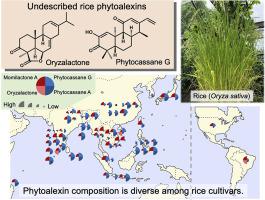当前位置:
X-MOL 学术
›
Phytochemistry
›
论文详情
Our official English website, www.x-mol.net, welcomes your feedback! (Note: you will need to create a separate account there.)
Natural variation of diterpenoid phytoalexins in cultivated and wild rice species
Phytochemistry ( IF 3.8 ) Pub Date : 2020-12-01 , DOI: 10.1016/j.phytochem.2020.112518 Keisuke Kariya 1 , Naoki Ube 2 , Makoto Ueno 3 , Masayoshi Teraishi 4 , Yutaka Okumoto 4 , Naoki Mori 4 , Kotomi Ueno 5 , Atsushi Ishihara 5
Phytochemistry ( IF 3.8 ) Pub Date : 2020-12-01 , DOI: 10.1016/j.phytochem.2020.112518 Keisuke Kariya 1 , Naoki Ube 2 , Makoto Ueno 3 , Masayoshi Teraishi 4 , Yutaka Okumoto 4 , Naoki Mori 4 , Kotomi Ueno 5 , Atsushi Ishihara 5
Affiliation

|
Rice (Oryza sativa) leaves accumulate phytoalexins in response to pathogen attack. The major phytoalexins in rice are diterpenoids such as momilactones, phytocassanes, and oryzalexins. We analyzed the abundance of momilactones A and B and phytocassanes A and D in UV-light-irradiated leaves of cultivars from the World Rice Core Collection (WRC). Both types of phytoalexins were detected in most cultivars; however, their accumulated amounts varied greatly from cultivar to cultivar. The amounts of momilactones A and B tended to be higher in japonica cultivars than those in indica cultivars. However, the accumulated amounts of phytocassanes were not related to differences in subspecies. In addition, variation in phytoalexin content was observed for seven wild rice species. During the analysis of momilactone A in cultivars from the WRC, two unknown compounds were detected in'Jaguary' and 'Basilanon'. We isolated these compounds from UV-light-irradiated leaves and determined their structures. The compound isolated from 'Jaguary' was an isomer of momilactone A that had an abietane skeleton, while that from 'Basilanon' was di-dehydrogenated phytocassane A; these compounds were denoted as oryzalactone and phytocassane G. Oryzalactone accumulated in only three cultivars, whereas phytocassane G accumulated in almost all of the cultivars from the WRC. These findings indicate the existence of large natural variation in the phytoalexin composition in rice.
中文翻译:

栽培稻和野生稻中二萜类植物抗毒素的自然变异
水稻 (Oryza sativa) 叶子在病原体攻击时会积累植物抗毒素。水稻中的主要植物抗毒素是二萜类化合物,如莫米内酯、植物卡桑和谷扎雷辛。我们分析了来自世界水稻核心收藏 (WRC) 的栽培品种的紫外线照射叶片中的 momilactones A 和 B 以及植物卡桑内酯 A 和 D 的丰度。在大多数品种中都检测到两种类型的植物抗毒素;然而,它们的累积量因品种而异。粳稻品种的内酯 A 和 B 含量往往高于籼稻品种。然而,植物卡桑的累积量与亚种的差异无关。此外,还观察到 7 种野生稻种的植物抗毒素含量存在差异。在分析来自 WRC 的品种中的莫米内酯 A 时,在“Jaguary”和“Basilanon”中检测到两种未知化合物。我们从紫外线照射的叶子中分离出这些化合物并确定了它们的结构。从'Jaguary'中分离出的化合物是具有松香烷骨架的momilactone A的异构体,而从'Basilanon'中分离出的化合物是二脱氢植物卡桑A;这些化合物被表示为谷扎内酯和植物卡桑 G。谷扎内酯仅在三个栽培品种中积累,而植物卡桑 G 在几乎所有 WRC 栽培品种中积累。这些发现表明水稻中植物抗毒素成分存在较大的自然变异。是具有松香烷骨架的莫米内酯 A 的异构体,而来自 'Basilanon' 的是双脱氢植物卡桑 A;这些化合物被表示为谷扎内酯和植物卡桑 G。谷扎内酯仅在三个栽培品种中积累,而植物卡桑 G 在几乎所有 WRC 栽培品种中积累。这些发现表明水稻中植物抗毒素成分存在较大的自然变异。是具有松香烷骨架的莫米内酯 A 的异构体,而来自 'Basilanon' 的是双脱氢植物卡桑 A;这些化合物被表示为谷扎内酯和植物卡桑 G。谷扎内酯仅在三个栽培品种中积累,而植物卡桑 G 在几乎所有来自 WRC 的栽培品种中积累。这些发现表明水稻中植物抗毒素成分存在较大的自然变异。
更新日期:2020-12-01
中文翻译:

栽培稻和野生稻中二萜类植物抗毒素的自然变异
水稻 (Oryza sativa) 叶子在病原体攻击时会积累植物抗毒素。水稻中的主要植物抗毒素是二萜类化合物,如莫米内酯、植物卡桑和谷扎雷辛。我们分析了来自世界水稻核心收藏 (WRC) 的栽培品种的紫外线照射叶片中的 momilactones A 和 B 以及植物卡桑内酯 A 和 D 的丰度。在大多数品种中都检测到两种类型的植物抗毒素;然而,它们的累积量因品种而异。粳稻品种的内酯 A 和 B 含量往往高于籼稻品种。然而,植物卡桑的累积量与亚种的差异无关。此外,还观察到 7 种野生稻种的植物抗毒素含量存在差异。在分析来自 WRC 的品种中的莫米内酯 A 时,在“Jaguary”和“Basilanon”中检测到两种未知化合物。我们从紫外线照射的叶子中分离出这些化合物并确定了它们的结构。从'Jaguary'中分离出的化合物是具有松香烷骨架的momilactone A的异构体,而从'Basilanon'中分离出的化合物是二脱氢植物卡桑A;这些化合物被表示为谷扎内酯和植物卡桑 G。谷扎内酯仅在三个栽培品种中积累,而植物卡桑 G 在几乎所有 WRC 栽培品种中积累。这些发现表明水稻中植物抗毒素成分存在较大的自然变异。是具有松香烷骨架的莫米内酯 A 的异构体,而来自 'Basilanon' 的是双脱氢植物卡桑 A;这些化合物被表示为谷扎内酯和植物卡桑 G。谷扎内酯仅在三个栽培品种中积累,而植物卡桑 G 在几乎所有 WRC 栽培品种中积累。这些发现表明水稻中植物抗毒素成分存在较大的自然变异。是具有松香烷骨架的莫米内酯 A 的异构体,而来自 'Basilanon' 的是双脱氢植物卡桑 A;这些化合物被表示为谷扎内酯和植物卡桑 G。谷扎内酯仅在三个栽培品种中积累,而植物卡桑 G 在几乎所有来自 WRC 的栽培品种中积累。这些发现表明水稻中植物抗毒素成分存在较大的自然变异。



























 京公网安备 11010802027423号
京公网安备 11010802027423号